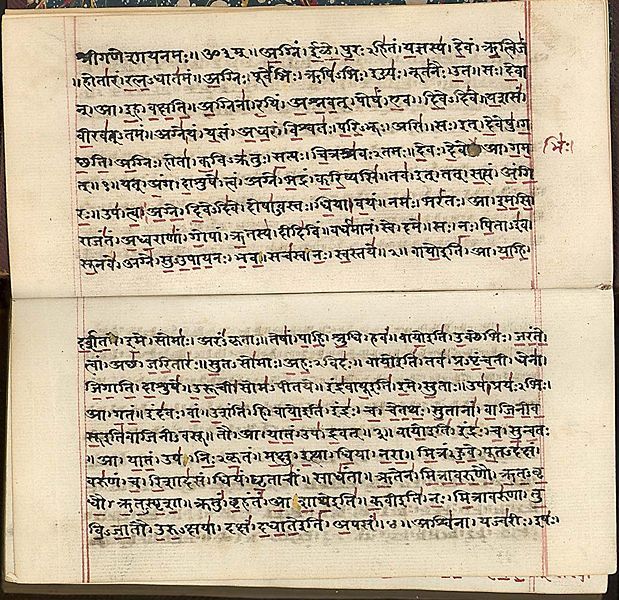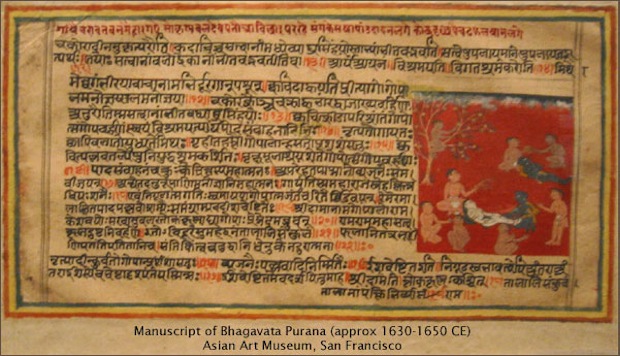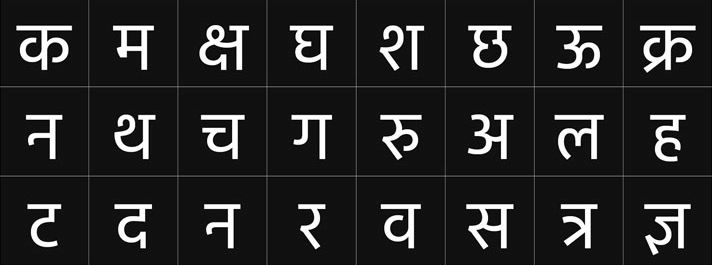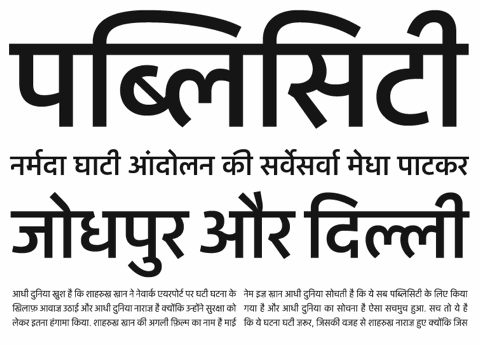Here is a link to the complete Vijnanabhairava Tantra in Devanagari. This will download the full text as a PDF file – whoops, not working as of today January 7 2009. Hmm.
Devanagari is a script that has come to be used to represent Sanskrit. Keep in mind that Sanskrit was designed to be chanted.

Rig Veda
The ancient manuscripts can be hard to read:


Devanagari can be typed into computers, of course:

Sutra 16 of the vijnanabhairava tantra, The Radiance Sutras.
This is a newly developed Devanagari typeface, called Fedra Hindi, designed by Peter Bilak & SN Rajpurohit of The Indian Type Foundry. I like the clean design.


“A Devanagari companion to Fedra Sans typeface. Originally developed for visual identities, designed to work equally well on paper and on the computer screen. Fedra Hindi is Unicode compliant font and comes in 5 weights with full support for conjuncts.” Read more . . .
I love the sample handwriting they worked with in developing Fedra:


from the Indian Type Foundry’s Flicker site.
Article in Wikipedia.
Devanagari
From Wikipedia, the free encyclopedia

Devanāgarī (देवनागरी, pronounced /ˌdeɪvəˈnɑːɡəri/ in English) is an abugida script. It is the main script used to write the Hindi, Marathi, and Nepali languages. Since the 19th century, it has become the most common script used to represent Sanskrit. Other languages using Devanagari (although not always as their only or principal script) include Sindhi, Bihari, Bhili, Marwari, Konkani, Bhojpuri, Pahari (Garhwali and Kumaoni), Santhali, Newari, Tharu, and Kashmiri. It is written and read from left to right.
Origins
Devanāgarī emerged around CE 1200 out of the Siddham script, gradually replacing the earlier, closely related Sharada script (which remained in parallel use in Kashmir). Both are immediate descendants of the Gupta script, ultimately deriving from the Brāhmī script attested from the 3rd century BCE; Nāgarī appeared in approx. the 8th century as an eastern variant of the Gupta script, contemporary to Sharada, its western variant. The descendants of Brahmi form the Brahmic family, including the alphabets employed for many other South and South-East Asian languages.
Sanskrit nāgarī is the feminine of nāgara "urban(e)", an adjectival vrddhi derivative from nagara "city"; the feminine form is used because of its original application to qualify the feminine noun lipi "script" ("urban(e) script", i.e. the script of the cultured). There were several varieties in use, one of which was distinguished by affixing deva "deity" to form a tatpurusha compound meaning the "urban(e) [script] of the deities (= gods)", i.e. "divine urban(e) [script]".
The widespread use of the name Devanāgarī is relatively recent; well into the twentieth century, and even today, simply Nāgarī was also in use for this same script. The rapid spread of the usage of Devanāgarī seems also to be connected with the almost exclusive use of this script in colonial times to publish works in Sanskrit, even though traditionally nearly all indigenous scripts had been employed for this language. This has led to the establishment of such a close connection between the script and Sanskrit that it is, erroneously, widely regarded as "the Sanskrit script" today.
(continued)
Here is a site describing some problems and solutions to reading and writing Sanskrit on a Mac:
http://devanaagarii.net/mac/#tiger
Devanagari on Tiger
On Mac OS 10.4.x ie Tiger, you can enable devanagari fonts using the System Preferences | International | Language | Edit List option.
Certain locale settings can be changed using the Formats tab.
For typing Hindi on a Tiger, you can choose the keyboard layout using the the two options available by default are Inscript and phonetic. Once you choose one of them, the icon for the input method would be displayed on the top right corner - in the dashboard.
To switch between Devanagari and other scripts, you may use the input switcher on your Mac using a mouse or you can set a keyboard shortcut, which by default is [Apple] + [Space], and it can be changed using the
Wait, do you still have trouble viewing Hindi? Perhaps the fonts package needs to be downloaded, you can see the instructions to install Hindi fonts for the Mac straight from Stevie's website.
Devanagari is a script that has come to be used to represent Sanskrit. Keep in mind that Sanskrit was designed to be chanted.

Rig Veda
The ancient manuscripts can be hard to read:


Devanagari can be typed into computers, of course:

Sutra 16 of the vijnanabhairava tantra, The Radiance Sutras.
This is a newly developed Devanagari typeface, called Fedra Hindi, designed by Peter Bilak & SN Rajpurohit of The Indian Type Foundry. I like the clean design.


“A Devanagari companion to Fedra Sans typeface. Originally developed for visual identities, designed to work equally well on paper and on the computer screen. Fedra Hindi is Unicode compliant font and comes in 5 weights with full support for conjuncts.” Read more . . .
I love the sample handwriting they worked with in developing Fedra:


from the Indian Type Foundry’s Flicker site.
Article in Wikipedia.
Devanagari
From Wikipedia, the free encyclopedia
| This article contains | Indic text.
Origins
Devanāgarī emerged around CE 1200 out of the Siddham script, gradually replacing the earlier, closely related Sharada script (which remained in parallel use in Kashmir). Both are immediate descendants of the Gupta script, ultimately deriving from the Brāhmī script attested from the 3rd century BCE; Nāgarī appeared in approx. the 8th century as an eastern variant of the Gupta script, contemporary to Sharada, its western variant. The descendants of Brahmi form the Brahmic family, including the alphabets employed for many other South and South-East Asian languages.
Sanskrit nāgarī is the feminine of nāgara "urban(e)", an adjectival vrddhi derivative from nagara "city"; the feminine form is used because of its original application to qualify the feminine noun lipi "script" ("urban(e) script", i.e. the script of the cultured). There were several varieties in use, one of which was distinguished by affixing deva "deity" to form a tatpurusha compound meaning the "urban(e) [script] of the deities (= gods)", i.e. "divine urban(e) [script]".
The widespread use of the name Devanāgarī is relatively recent; well into the twentieth century, and even today, simply Nāgarī was also in use for this same script. The rapid spread of the usage of Devanāgarī seems also to be connected with the almost exclusive use of this script in colonial times to publish works in Sanskrit, even though traditionally nearly all indigenous scripts had been employed for this language. This has led to the establishment of such a close connection between the script and Sanskrit that it is, erroneously, widely regarded as "the Sanskrit script" today.
(continued)
Devanagari on Macs
Here is a site describing some problems and solutions to reading and writing Sanskrit on a Mac:
http://devanaagarii.net/mac/#tiger
Devanagari on Tiger
On Mac OS 10.4.x ie Tiger, you can enable devanagari fonts using the System Preferences | International | Language | Edit List option.
Certain locale settings can be changed using the Formats tab.
For typing Hindi on a Tiger, you can choose the keyboard layout using the the two options available by default are Inscript and phonetic. Once you choose one of them, the icon for the input method would be displayed on the top right corner - in the dashboard.
To switch between Devanagari and other scripts, you may use the input switcher on your Mac using a mouse or you can set a keyboard shortcut, which by default is [Apple] + [Space], and it can be changed using the
- System Preferences | International, or
- System Preferences | Keyboard & Mouse options
Wait, do you still have trouble viewing Hindi? Perhaps the fonts package needs to be downloaded, you can see the instructions to install Hindi fonts for the Mac straight from Stevie's website.